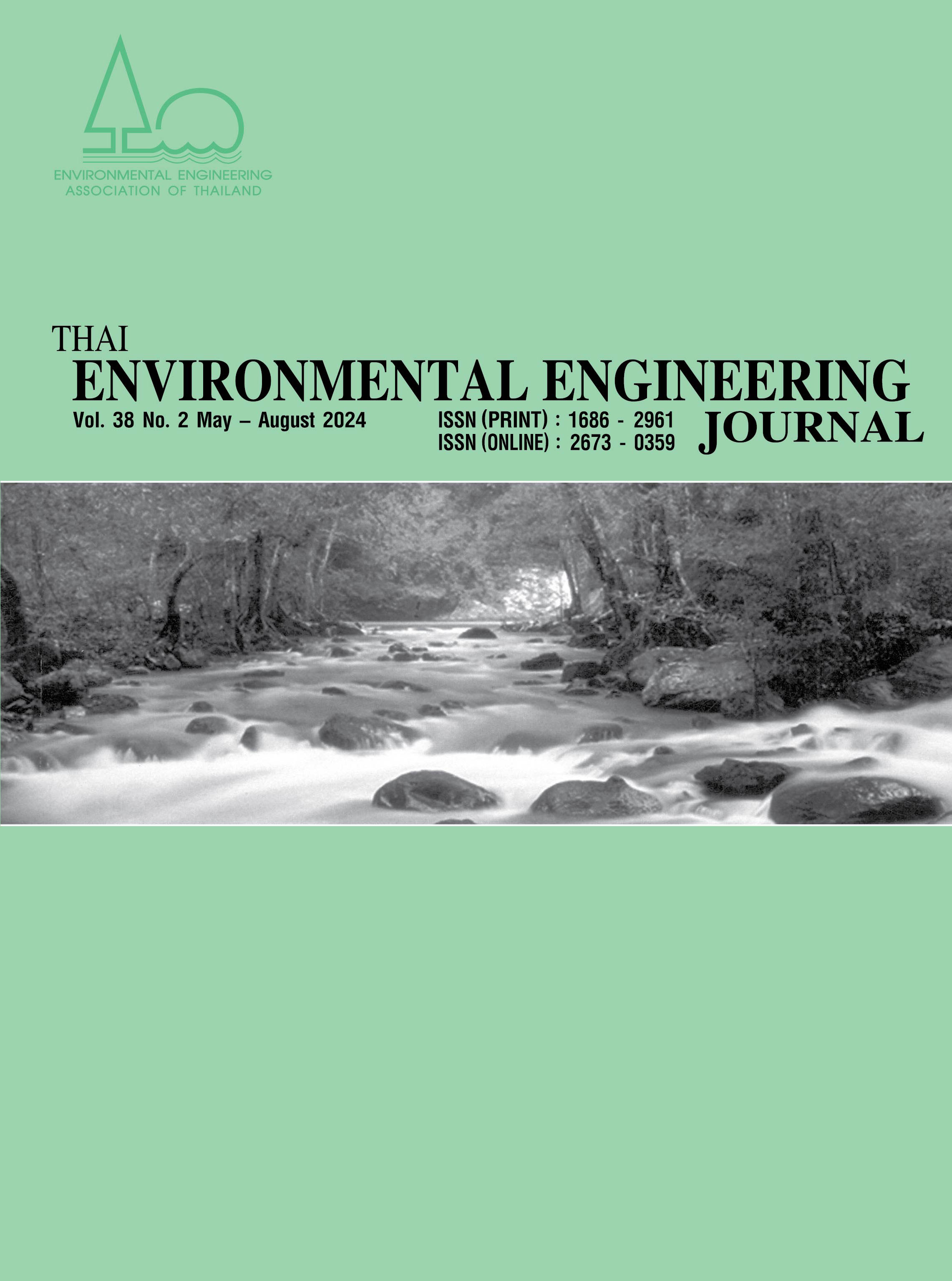Effect of In-situ Aeration on Leachate Qualities under Uncompacted Municipal Solid Waste Disposal Conditions
Main Article Content
Abstract
This research was carried out to investigate the effect of in-situ aeration on leachate qualities in simulated lysimeters containing uncompacted municipal solid wastes representing typical municipal solid waste disposal conditions in Thailand. The study was performed by applying different aeration conditions to the lysimeters and leachate volume and its chemical characteristics were monitored over 6 months. The air supply conditions varied from natural ventilation to active aeration at rates of 0.18 and 0.36 l/min. The generated leachate was compared to the control lysimeter representing typical anaerobic disposal conditions. The lysimeters operated at a high airflow rate of 0.36 l/min and natural ventilation had their leachate qualities in terms of organic (BOD, COD) and nitrogen (TKN) well stabilized by more than 90% within 30 days. Under low aerated conditions (0.18 l/min), organic stabilization in leachate required more than 100 days whereas TKN removals were also highly fluctuated. Based on the results from this study, waste disposal operation under natural aeration through a ventilation pipe installed into the uncompacted waste layer would be sufficient to reduce organic and nitrogen pollutants in leachate to the same level as the highly aerobic landfill condition.
Article Details
References
Warith, M.A. and Takata, G.J. 2004. Effect of aeration on fresh and aged municipal solid waste in a simulated landfill bioreactor. Water Quality Research Journal of Canada. 39(3): 223-229.
Chiemchaisri, C., Chiemchaisri, W., Sittichoktam, S. and Tantichatakarun, T. 2009. Application of partially submerged bioreactor landfill for leachate management in the tropics. International Journal of Environment and Waste Management. 3(1/2): 78-90.
Weerasekara, R., Chiemchaisri, C. and Chiemchaisri, W. 2010. Influence of solid waste disposal conditions on organic pollutants discharged from tropical landfill. Asian Journal of Water, Environment and Pollution. 7(1): 107-112.
Erses, A.S., Onay, T.T. and Yenigun, O. 2008. Comparison of aerobic and anaerobic degradation of municipal solid waste in bioreactor landfills. Bioresource Technology. 99: 5418-5426.
Theng, L.C., Matsufuji, Y. and Hassan, M.N. 2005. Implementation of the semi-aerobic landfill system (Fukuoka method) in developing countries: A Malaysia cost analysis. Waste Management. 25: 702-711.
Ritzkowski, M. and Stegmann, R. 2012. Landfill aeration worldwide: Concepts, indications and findings. Waste Management. 32: 1411-1419.
Brandstätter, C., Prantl, R. and Fellner, J. 2020. Performance assessment of landfill in-situ aeration - a case study. Waste Management. 101: 231-240.
Gómez, M.A., Baldini, M., Marcos, M., Martínez, A., Fernández, S. and Reyes, S. 2012. Aerobic microbial activity and solid waste biodegradation in a landfill located in a semi-arid region of Argentina. Annals of Microbiology. 62: 745-752.
Fricko, N., Brandstätter, C. and Fellner, J. 2021. Enduring reduction of carbon and nitrogen emissions from landfills due to aeration? Waste Management. 135: 457-466.
Sutthasil, N., Chiemchaisri, C., Chiemchaisri, W., Wangyao, K., Towprayoon, S., Endo, K. and Yamada M. 2014. Comparison of solid waste stabilization and methane emission from anaerobic and semi-aerobic landfills operated in tropical condition. Environmental Engineering Research. 19(3): 261-268.
Aziz, A.Q., Aziz, H.A., Yusoff, M.S. and Barshir, M.J.K. 2010. Leachate characterization in semi-aerobic and anaerobic sanitary landfills: a comparative study. Waste Management. 91: 2608-2614.
Nag, M., Shimaoka, T. and Komiya, T. 2016. Impact of intermittent aerations on leachate quality and greenhouse gas reduction in the aerobic-anaerobic landfill method. Waste Management. 55: 71-82.
Ma, J., Li, Y. and Li, Y. 2021. Effects of leachate recirculation quantity and aeration on leachate quality and municipal solid waste stabilization in semi-aerobic landfills. Environmental Technology and Innovation. 21: 101353.
Lui, K., Lv, L., Li, W., Wang, X., Han, M., Ren, Z., Gao, W., Wang, P., Liu, X., Sun, L. and Zhang, G. 2023. Micro-aeration and leachate recirculation for the acceleration of landfill stabilization: enhanced hydrolytic acidification by facultative bacteria. Bioresource Technology. 387: 129615.
Ko, J.H., Ma, Z., Jin, X. and Xu, Q. 2016. Effects of aeration frequency on leachate quality and waste in simulated hybrid bioreactor landfills. Journal of the Air and Waste Management Association. 66(12): 1245-1256.
Li, W., Sun, Y., Wang, H. and Wang, Y. 2018. Improving leachate quality and optimizing CH4 and N2O emissions from a pre-aerated semi-aerobic bioreactor landfill using different pre-aeration strategies. Chemosphere. 209: 839-847.
Traitaned, P. and Sakulrat, J. 2016. Effect of aerated leachate recirculation on decomposition condition in municipal solid waste (MSW) landfill. Thai Environmental Engineering Journal. 30(2): 49-56.
Ma, J., Liu, L., Xue, Q., Yang, Y., Zhang, Y. and Fei, X. 2021. A systematic assessment of aeration rate effect on aerobic degradation of municipal solid waste based on leachate chemical oxygen demand removal. Chemosphere. 263: 128218.
Rendra, S. 2007. Comparative Study of Biodegradation of Municipal Solid Waste in Simulated Aerobic and Anaerobic Bioreactors Landfills. University of Ottawa, Canada.
Morello, L., Raga, R., Lavagnolo, M.C., Pivato, A., Ali, M., Yue, D. and Cossu, R. 2017. The S.An.A. concept: semi-aerobic, anaerobic, aerated bioreactor landfill. Waste Management. 67: 193-202.
Soil and Plant Analysis Council. 1999. Soil Analysis Handbook of Reference Method. CRC Press. Washington DC.
APHA. 2012. Standard Methods for the Examination of Water and Wastewater, 22nd Edition, American Public Health Association, Washington DC.
Jin, P., Bian, S., Yu, W., Guo, S., Lai, C., Wu, L., Zhao, H., Xiao, K., Liang, S., Yuan, S., Huang, L., Wang, S., Duan, H., Gan, F., Chen, W. and Yang, J. 2023. Insights into leachate reduction in landfill with different ventilation rates: balance of water, waste physicochemical properties, and microbial community. Waste Management. 156: 118-129.
Sun, Y., Sun, X. and Zhao, Y. 2011. Comparison of semi-aerobic and anaerobic degradation of refuse with recirculation after leachate treatment by aged refuse bioreactor. Waste Management. 31: 1202-1209.
Huang, Q., Yang, Y., Pang, X. and Wang, Q. 2008. Evolution on qualities of leachate and landfill gas in the semi-aerobic landfill. Journal of Environmental Sciences. 20: 499-504.


